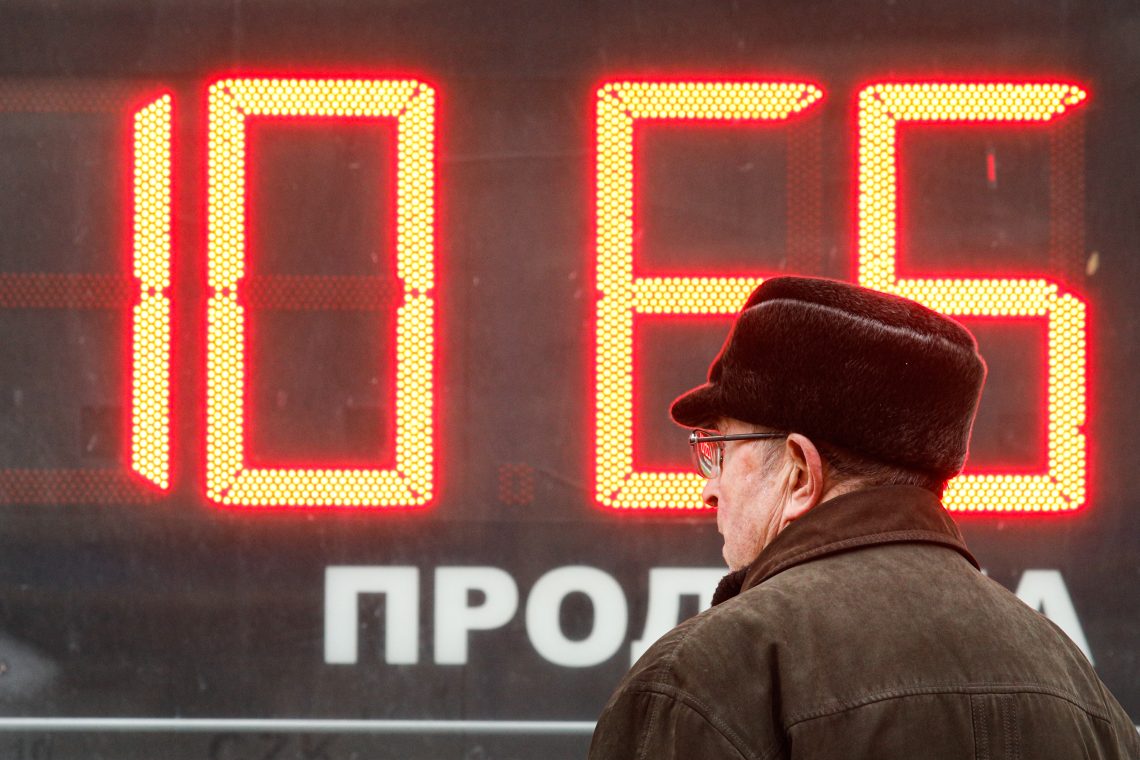Can Russia’s tax system withstand sanctions?
Russia’s tax regime puts a heavy burden on labor costs and has done little to remedy the economy’s dependence on oil and gas exports.

In a nutshell
- The Russian tax system is convenient for individuals
- It places heavier burdens on entrepreneurs and labor costs
- Sudden tax hikes have been a recent trend before the latest sanctions
The Russian tax system began to take shape after the collapse of the Soviet Union in December 1991. That month, a law “on the fundamentals of the Russian Federation’s tax system” was adopted, introducing a series of new revenue sources – including a value-added tax, income tax, excise taxes on alcohol and tobacco products, and other levies. In 1998, the first part of the Russian Federation’s Tax Code was approved, followed by the second part in 2000. This code constitutes the main legislative act in the Russian tax system.
Like most tax systems in federal states, Russia’s is organized on three levels: federal, regional and local (or municipal). Of the country’s 14 varieties of taxes, eight are levied on the federal level (including state duty), three by the regional and three by the local authorities. Standing apart from this total are five special tax regimes, along with mandatory insurance payments and a new, experimental tax for self-employed persons, introduced in 2019.
In terms of collection, almost all Russian taxes are direct, that is, charged on the income or value of the taxpayer’s property. The sole exceptions are VAT and excise taxes, which are included in the cost of goods, services or labor. In effect, these indirect taxes are paid by buyers of these goods, services or labor, with the seller acting as an intermediary between the taxpayer and the state.
Federal taxes
Federal taxes include a flat personal income tax of 13 percent for annual incomes of up to 5 million rubles (approximately $45,000 after the ruble’s recent plunge following Western sanctions). For personal income above that level, the marginal rate rises to 15 percent. Of the revenue generated, 85 percent is transferred to regional budgets and the rest to local (municipal) governments. Corporate profits are taxed at 20 percent, with 15 percent of the revenue going to the federal budget, and 85 percent to the regions. The value-added tax (VAT) is set at 20 percent – 10 percent for food and medical products – and is fully paid into the federal budget.
Sanctions had immediate, radical effects on Russia’s financial situation, including a rapid devaluation of the ruble and severe disruption of both exports and imports.
Other federal levies include excise taxes on alcohol (except beer and low-alcohol beverages), tobacco, passenger cars, motorcycles and gasoline. Almost all revenue from these taxes goes to the federal budget. Commercial users are also subject to a water tax and a mineral extraction tax, almost all of which go to the federal budget.
In addition, the federal level has introduced and regulates so-called special tax regimes. These include simplified taxation for small businesses with fewer than 130 employees and less than 200 million rubles of income per year ($1.9 million). Taxpayers can choose to pay 6 percent of their total income or 15 percent on the difference between income and expenses. At the same time, regions have the power to override these rates and apply lower ones. Individual proprietors without corporate status pay 6 percent of their income.
Russia’s second-largest source of tax revenue (after VAT) is the tax on mineral resource extraction, which is calculated according to a complex, company-specific formula taking into account, for example, the depletion of mineral reserves. A single preferential taxation system for agriculture replaces a number of other taxes applied to other sectors, including income tax.
Regional and local taxes
Regional taxes are also approved at the federal level. However, a distinct feature of the Russian tax system is that regional authorities have the power to change tax conditions at their discretion, within the limits stipulated in the Tax Code. All such changes must be enacted in regional laws. These levies include the vehicle tax, the gambling tax, and the corporate property tax. Regional government bodies may also introduce and amend special tax regimes as specified in the Tax Code.
The same applies to taxes imposed by local government bodies, which may be changed or added within the framework set in the all-Russian Tax Code. Local taxation includes the land tax, the personal property tax, and a trade fee for small businesses involved in cash-based commerce with the general public.

Insurance contributions
Russia’s tax system also includes mandatory insurance payments made solely by the employer based on payroll. They comprise a 22 percent contribution to the state Pension Fund, a 2.9 percent contribution to the Social Insurance Fund (which covers sick leave and a number of benefits for women with children), a 5.1 percent contribution to the Compulsory Medical Insurance Fund, along with various industry-specific contributions to insure risk from workplace accidents or occupational diseases.
In many cases, preferential rates are offered for these contributions. For example, small and medium-sized businesses since 2020 have enjoyed a 50 percent discount on mandatory insurance contributions compared with other employers.
System quality
Several criteria can be used to assess the quality of the Russian tax system.
The first is convenience to individual taxpayers. Here one must note the simplicity of the virtually flat personal income tax of 13 percent. This is extremely low relative to almost all economically developed countries, which also, as a rule, use a progressive scale of taxation. At the top end, these rates can reach as high as 45 percent in Germany and France.
In addition, Russia’s Federal Tax Service has switched to modern, contactless forms of collecting many taxes, including from individuals. The 13 percent personal income tax is deducted automatically at the place of income and only in exceptional cases do taxpayers need to file returns for income on which, for various reasons, no tax has not been paid (e.g., rents or other real-estate income). Electronic filing of tax declarations and returns is routine. Since employers are responsible for mandatory insurance contributions, they also do not concern individual taxpayers.
For individual taxpayers, the major unresolved problem is transferring tax income to the regional budget of their place of work rather than their place of residence. Usually, the two places coincide, but not always. For example, many people commute to work in Moscow but are domiciled in the surrounding region, which is responsible for providing them with healthcare, education, utilities and other services.
The second criterion for measuring a tax system is its convenience for employers. Here, we can observe several significant problems.
One has already been mentioned. Employers are responsible for paying mandatory insurance contributions in full, which – not counting certain industry-specific payments – amount to a sizeable 30 percent of the total wage fund. Once added to personal income tax, it turns out that Russia’s tax burden on labor is larger than in many developed countries. On average, it amounts to 36.6 percent of the commercial profit for medium-sized companies, according to a 2020 study by PricewaterhouseCoopers and the World Bank. That compares to a global average of 16.3 percent. In the United States, the effective tax on labor is only 9.8 percent; in Kazakhstan, 10.1 percent; in the United Kingdom, 12 percent, and even in Germany, 21.5 percent. This differential has a negative impact on entrepreneurial activity and causes a significant portion of wages to be diverted to the shadow economy.
The Russian government has grasped this problem. Finance Minister Anton Siluanov has remarked that the tax burden on labor “is really exorbitant. I understand that perfectly.” As mentioned above, insurance payments for small and medium-sized businesses were cut in half, but any further cuts have been hindered by the government’s fears of not receiving sufficient revenue to finance benefits spending.
The big question now is whether the Russian government can continue to raise direct and indirect tax rates given the current geopolitical situation and the severe economic shock.
A third yardstick for measuring Russia’s tax system is dependence on oil and gas revenue. In various years, the Finance Ministry estimates the share of such taxes in the total federal budget has ranged from 36 percent to 51 percent. Here, of course, the Russian economy’s specialization in raw materials exports, primarily hydrocarbons and metals, is crucial.
Another way to assess Russia’s tax system is to look at how well it distributes revenue among the different levels of government – federal, regional and local. In 2020, according to one study of consolidated budget revenue (apart from insurance contributions), the federal budget took 50 percent for itself. Is this ratio optimal?
The answer hinges on whether the current distribution allows regions to be financially independent, generating enough of their own tax revenue to cover expenditures. Here we see obvious imbalances. Of Russia’s 85 regions, only 13 fully meet their budget needs from their own resources. These include the highly developed and wealthy Moscow and St. Petersburg cities, the industrial regions of Kaluga, Leningrad, Samara and Sverdlovsk, the Tatarstan Republic, and rich oil- and gas-producing regions such as the Sakhalin and Tyumen regions, along with the Nenets, Khanty-Mansi and Yamalo-Nenets autonomous districts. All other regional governments can only make ends meet with help from the federal budget. This situation can hardly be regarded as normal.
Thus, of the four main criteria for judging the quality of Russia’s tax system, two must be assessed unfavorably.
Scenarios
The government has repeatedly stated the need for stable tax conditions. This is confirmed in the “Main Directions of the Budget, Tax and Customs Tariff Policy” prepared by the Federal Ministry of Finance for 2022 and for the planning period of 2023 and 2024. This document proposes purely technical adjustments. mostly concerning tax administration.
However, Russian political reality is full of surprises. We mentioned the surprise announcement in 2020 of a twofold reduction in mandatory insurance payments for small and medium-sized businesses. But the prevailing trend has been in the opposite direction – toward sudden tax increases. For example, the decision to increase the top marginal rate on personal income to 15 percent had not been previously announced. Just as unexpectedly, the main VAT rate jumped from 18 percent to 20 percent on January 1, 2019.
Another trend is the practice of levying windfall taxes on certain business sectors, as happened in 2021 with ferrous metallurgy. The government decided that the metallurgical companies had “bilked” the state out of 100 billion rubles (almost $9 billion) as rising prices, including on the domestic market, swelled their profits. As a result, special export duties were introduced, delivering even more money to the budget than planned.
The biggest surprise, of course, is the Russian-Ukrainian conflict that broke out on February 24, 2022, resulting in the imposition of unprecedented economic sanctions on Russia. This had immediate, radical effects on Russia’s financial situation, including a rapid devaluation of the ruble and severe disruption of both exports and imports. To date, however, there has been no serious adjustment in the tax system. As of the second week of March, the only noticeable changes include the cancellation of VAT for individuals buying gold bullion and the declaration of a three-year VAT holiday for the domestic IT industry.
In terms of policy, the big question now is whether the Russian government can continue to raise direct and indirect tax rates given the current geopolitical situation and the severe economic shock. For now, it appears any radical change in the tax regime is unlikely, since the government will probably respond to the budget shortfall with monetary emission. This deficit spending will propel the inflation rate to at least 20 percent by the end of the year, reducing real incomes, but pumping up nominal budget revenue.








